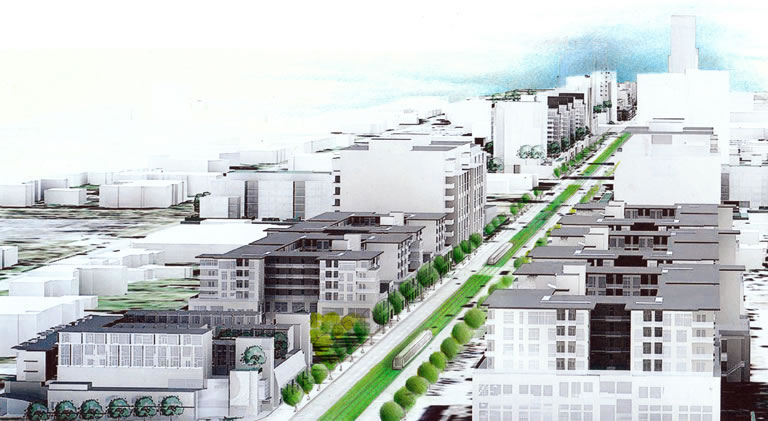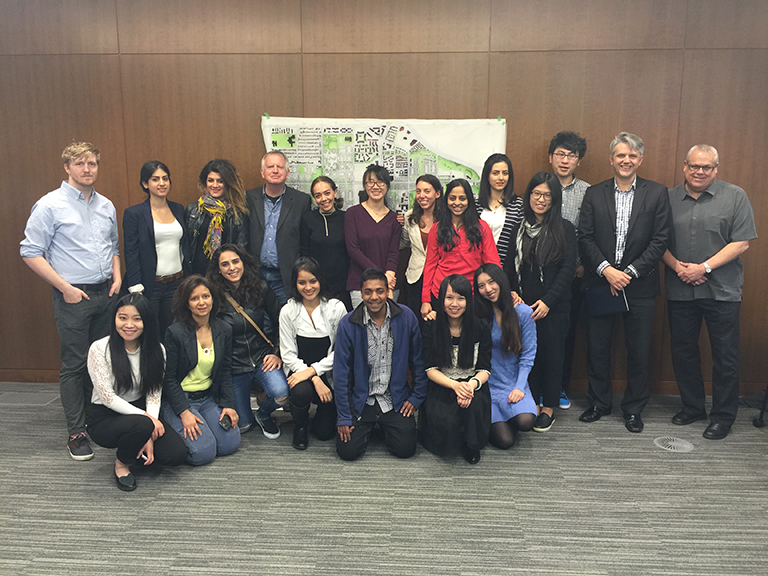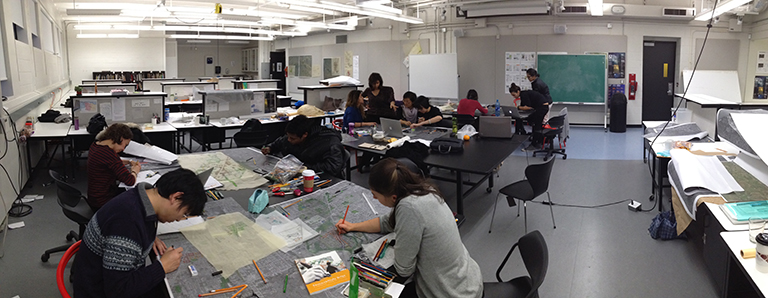Framing the Future
In the typical scenario, a student studying urban design and architecture might work on a hypothetical problem, creating a ‘solution’ that will, in reality, never be realized. Until he or she graduates, all that energy, creativity and innovation has no ‘real’ place to go.
At UBC Vancouver, however, students have an opportunity to work alongside seasoned urban designers and professionals, helping shape a living canvas 316 square kilometers in size, a population of half a million and growing fast in all manners, demographics, directions and challenges. Doing ‘real design’ and making valuable career connections in the process.
In 2014, The School of Architecture and Landscape Architecture (SALA) partnered with the City of Surrey to bring UBC students ‘within the city walls’ and involve them with urban design, land-use and transportation challenges in what is one of Canada’s fastest growing and arguably most dynamic metropolis in terms of urban design and innovation.
Surrey committed $260,000 over three years to SALA’s comprehensive Master of Urban Design program intended to give MUD graduates the focused skills to address the challenges of a rapidly urbanizing world and its expanding cities – beginning with Surrey.
The City of Surrey is supporting three MUD Funded Studios on the regional, district and local scales. The studios are innovative idea, design and energy generators, and a fundamental component of a curriculum that tightly ties SALA research to the concerns of its community partners.
The new program’s inaugural cohort of 16 students began their studio studies and interactions with their Surrey colleagues in the 2014/15 academic year.
As per the City’s request, the Winter MUD studio will focus on the Guildford area and what UBC Professor Patrick Condon, Master of Urban Design Chair, calls “a magnet” for South Asian families and what is now the city’s largest ethnic group.
“Surrey’s growth reveals patterns of change that are happening through the world,” explains Condon. “This changing population leads to a changing city and a need to reconsider all of our assumptions about how the city should be designed and built. Our urban design program is designed to both serve our region and explore topics of global relevance. Surrey fits that bill.”
The 2015 UBC/SALA inaugural cohort of students conducted citywide investigations to identify what Scot Hein, UBC professor of urban design and campus urban designer, calls “contextually thoughtful strategies for doubling housing and employment opportunities by 2050.”
With an eye on Guildford, Hein says MUD students are fashioning a proactive, “socially responsible dimension of the proposed urban framework” emphasizing the area’s “image of place, expression, community focused housing and entrepreneurial support systems.” Stepping back, the students themselves are being fashioned to act as “leaders capable of initiating thoughtful transformation in any world context at any scale.”
All the while not flinching from supporting and “taking on tough political challenges” that face any local jurisdiction weathering inevitable major changes. Students look at the friction points and provide what Hein calls professional-quality “viable, contextual and pragmatic strategies” to civic leaders while attempting to “balance the interests of all stakeholders.”
Much more than just ‘getting your feet wet’, these students are capable partners that add value to the conversation and ultimately, to the success of the project.
Hein says the MUD studios’ R&D output is intended to “only take weeks to prepare” where typical ‘engagement processes may take much longer: “It is hoped that the cohort’s research and design work is in service to Surrey’s interests for years to follow.”
Don Luymes, Surrey manager of community planning and adjunct professor at UBC School of Architecture and Landscape Architecture, believes the university/city partnership has “great promise and potential” and for good reasons: “It brings staff into contact and dialogue with passionate and engaged students and faculty.”
“They can provide a fresh perspective and solutions that are not fettered by our traditional approaches to issues. This allows us to consider a wider range of policy options and opens our eyes to new possibilities.”
Supporting the new Master of Urban Design program simply makes sense, concludes Luymes: “The modest investment provides a much greater return to the community and to society at large.”
And especially for one proactive and engaged city that is working with a unique group of UBC students helping to shape its future.
Read more about
Community EngagementRead more Community Engagement stories:
Related Content
MUCH MORE THAN JUST ‘GETTING YOUR FEET WET’, THESE STUDENTS ARE CAPABLE PARTNERS THAT ADD VALUE TO THE CONVERSATION AND ULTIMATELY, TO THE SUCCESS OF THE PROJECT.
Campus
Vancouver

